Huang Yi was a master of seal cutting art in the mid-Qing dynasty. His friends came from scholars of school in Qianlong and Jiaqing periods, senior civil officers and self-employed artists. It was the love for seals that push them to become close friends. These three kinds of people, including Weng Fanggang, Jiang Ren, Xi Gang and Yao Lide, were the owners of seals engraved by Huang Yi.
However, apart from these three kinds of people, Huang Yi shared a special camaraderie with the Zhang’s in Xuzhou.

▲Xiling Yinshe 2020 Spring Auction
QING DYNASTY A SHOUSHAN 'FURONG' STONE 'BEAST' SEAL ENGRAVED BY HUANG YI FOR ZHANG FUSHENG'S PRIVATE USE
Dated 1784
Illustrated: 1. Letter Album from Huang Yi to Zhang Aiding, no. Xin 00155999
2. Album of Seal Impressions of Ding Jing and Huang Yi, Youzheng Book Publishing House, Republic of China
period
3. China Seal Cutting Series: Huang Yi, p. 125, Nigensha, 1982
4. Chinese Seal Cutting Collection, vol. 5, Zhejiang Ancient Books Publishing House, 2007
5. Chinese Seal Cutting Styles in Different Dynasties·Zhejiang School of Qing Dynasty, vol. 1, p. 128,
Chongqing Publishing House, 2011
6. Album of Seal Impressions of Ding Jing and Huang Yi, pp. 86-87, People's
Fine Arts Publishing House, 2012
7. Study on Huang Yi's Letters Collected by the Imperial Palace, p. 147, Publishing House of the Palace
Museum, 2014
8. Research on the Seal Impression of Huang Yi’s Letters Collected by the Imperial Palace, p. 98, issue no.07
Calligraphy, 2018
Literature: 1. Research on the Communication between Huang Yi and Zhang from Tongshan: Focus on the Letters from
Huang Yi to Kenson Gosatsu Collected by the Imperial Palace, p. 199, Chinese Calligraphy, issue no. 7, 2016
2. Huang Yi's Chronology, p. 123, Shangdong Pictorial Publishing House, 2017
3.5×2.7×6.7cm
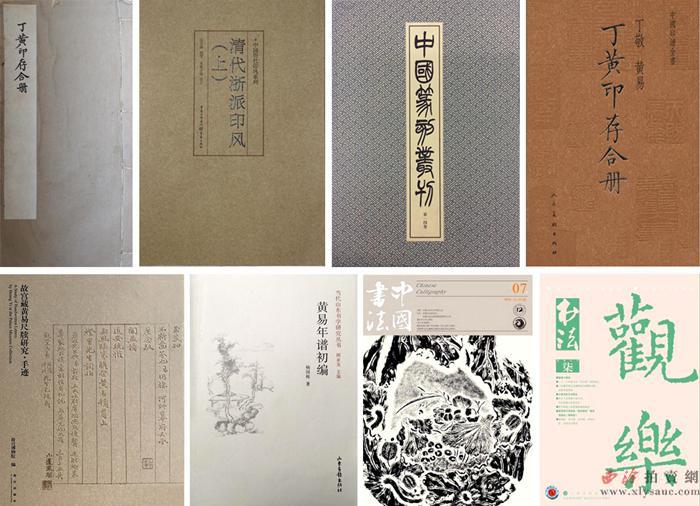
Introduction of the seal engraver: Huang Yi (1744-1802), style name Dayi, pseudonym Xiaosong or Qiu’an, was based in Hangzhou, Zhejiang. He was a prominent archaeologist, seal engraver, a collector of antique bronzes, stele of the Han and Northern Wei periods, and rubbings made from old steles. He learned after Ding Jing and other masters of Song and Yuan dynasties. Huang, along with Ding Jing, Jiang Ren and Xi Gang, was one of the famous eight masters of the Xiling Society of Seal Cutting. Huang Yi was also a well-known calligrapher and painter. Most of his landscape paintings echo the themes and stylizations associated with the orthodox tradition.
Introduction of the seal owner: Zhang Fusheng (1725-?), style name Ziji and pseudonym Sumen, was the son of Zhang Bingxu. Born with a love for learning, Zhang was quite famous when he was young. He used to serve as an official in Wenshang, Quanzhou and Henan. Due to his talents in governing the river, he was then recommended as an official dedicated to river harness. His poems were compiled into the book Sumen Shanren’s Poems.
Xiling Yinshe 2020 Spring Auction: Viewing: July 28-30, Auction: July 31-August 3
The Department of Seals
Tel:+86 571-8788 6968 E-mail:[email protected]
This ‘Jian Yuan Lao Ren’ seal was inscribed with time, location and figures. The owner of the seal was like a father to Huang Yi, therefore, the seal was sent to pay a debt of gratitude. Huang was forty-one, in the prime of life, in 1784 when he engraved the seal, which was collected in Album of Seal Impressions of Ding Jing and Huang Yi. Zhang and Huang were all from families dedicated to river harness. At that time, Zhang was building the Jianyuan Garden at home after resignation, while Huang was on a business trip. The seal was made on the journey as a gift to Zhang Fusheng for his 60th birthday.
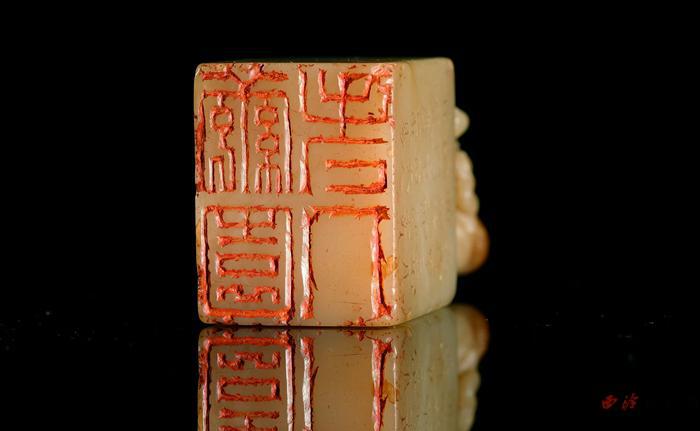
Jianyuan Garden was a dream of Zhang Fusheng, and a conclusion for his life-long career as a canal officer. Zhang’s resignation, on the face of it, was because of his poor health, but actually was a result of the intrigues of the officialdom. As a colleague of Zhang Fuyuan, Huang Yi must have a mixed feeling when he heard the news. He poured his sentiment into the seal. Therefore, we can consider the seal to be the incarnation of Huang Yi’s own career. While Huang spent his life in pursuit of the perfection in seal engraving, what we can learn is that we must seek for the perfection as a human.
According to Shan Dong Yan Zhou Fu Yun He Tong Zhi Qian Tang Huang Jun Mu Zhi Ming, written by Pan Tingjun, that the local authority did a great job in the 45th and 49th year of Qianlong period of Qing dynasty (1780 and 1784) when the Emperor Qianlong returned to Beijing from his tour in the south via the Beijing-Hangzhou Grand Canal. It was the 6th tour when Huang Yi got promoted for his good performance as the canal officer. In August, the levee of the Yellow River in Suizhou of Henan broke. The imperial dispatched a scholar of the Qing imperial court named A Gui who was almost 70 years old to supervise the levee construction which was completed after three months. The inscription of the seal implies that Huang Yi was in Suizhou in September of 1784, which is supposed to be related with the arrival of A Gui at that time.

Zhang Fusheng was asked by Yao Lide to stay in the government for his talent and sophistication in governing the river in May, 1779. However, offended by Huang’s comments on river course two months later, A Gui submitted a written statement to the emperor requiring to dismiss and punish Zhang Fusheng, who was almost pushed to parade in shackles. Fortunately he was exonerated later and recommended to be an examiner of the imperial examination. But Zhang resigned in excuse of illness in 1781 after he completed the levee construction, just 3 years ahead of the creation of the seal, according to Qian Long Chao Shi Lu Juan (Vol. 1083).
Huang Shugu, known as Songshi Xiansheng and father of Huang Yi gave Huang a nickname Xiaosong after himself. Huang Shugu has a work He Fang Si Yi and Huang Yi practiced the theory in this book. When Huang Yi left Hangzhou at fifteen years old, Zhang Fusheng started to play a role of his father instead. Zhang was nineteen years older than Huang. After offering tributes to the emperor, Zhang was assigned to be the local magistrate of Shangyu in Henan. Because of the flooding of the Yellow River and his outstanding ability of flood control, Zhang Fusheng was recommended to combat the flood as vice magistrate of Beihe under the Kaifeng Government.
Huang Yi got acquainted with Zhang Fusheng since the beginning of his career. Zhang took good care of him in an economic way. From the survived letters by Huang Yi, we can see his economic situation was not good, which bewilders experts who study on him. However, it is not difficult to understand for a person who collects antiques, just similar to those who bid desperately while crying for tight budget in nowadays. That is why Huang Yi appreciated Zhang Fusheng and his sixth son for their generousness to offer him food and clothes. As such, Huang treated Zhang as his father. According to the pedigree of Zhang Fusheng’s clan in Pengcheng, Zhang Aiding ranks the sixth among Zhang Fusheng’s children, so the sixth son is supposed to be Zhang Aiding.

The sorting and textual research on Huang Yi’s letters in recent years have dug deeper and unveiled the people who had close relationship with Huang. As the top collector of Huang Yi’s letters, the Palace Museum housed five letters dedicated by Huang Yi to Zhang Aiding, which were specially collected with five seal impressions including ‘Jian Yuan Lao Ren’, ‘Tai Ping Zhi Men’, ‘Su Men’, ‘Su Men Suo Cang’ and ‘Zhang Ai Ding Yin’. Among them, ‘Su Men’ is the pseudonym of Zhang Fusheng.
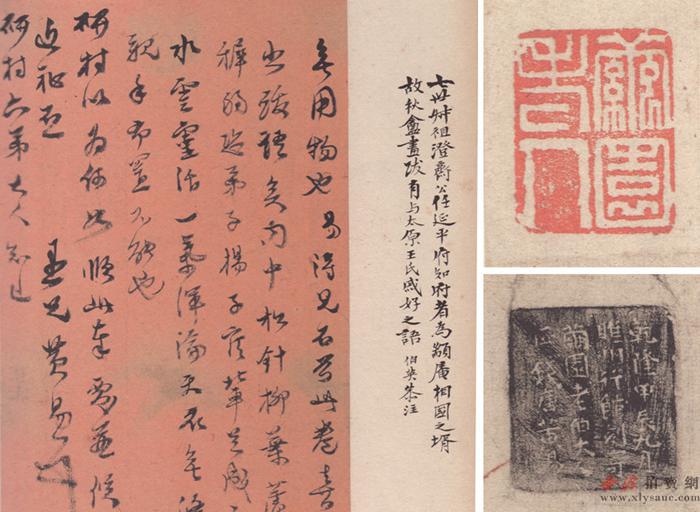
There are many letters between Huang Yi and Zhang’s family about paintings, calligraphic works, ancient books and appreciation of seals, of which the most famous one is Wang Chuan Tu painted by Wang Yuanqi and now collected by the Metropolitan Museum of Art. From Zhang Fusheng back to his previous three generations, Zhang’s family had a close tie with the painters of Loudong School in early Qing Dynasty. Their ancestor Zhang Daorui was a good friend of Wang Shimin’s family, Wang Hui and Yang Jin, and his seventh younger brother Zhang Daopei even married Wang Shimin’s granddaughter, a cousin of Wang Yuanqi.
Ruan Yuan once said, Huang Yi did not often make seals for others, and even his closest friend was given one or two, which showed Ruan’s respect and admiration to Huang. The textual research on Huang and Ruan’s seals has proved Huang Yi was the teacher of Ruan Yuan.
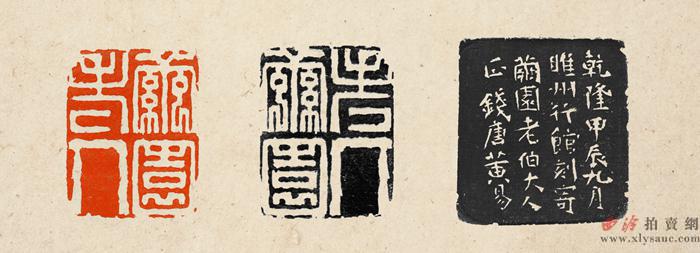
On this seal, the four Chinese characters ‘Jian Yuan Lao Ren’ were all written in an ancient imperial seal script. According to Shuo Wen, the character ‘繭Jian (cocoon)’ consists of two characters of ‘系Xi (silk) ‘ and ‘蟲Chong (worm)’ inside the character ‘芾Fu (embroidery)’ which is an abbreviated form of ‘黹Fu’. The character ‘袁Yuan’ features its lower part like the character ‘凹’ and the entire character is not square with more space at its downside than upside. Though written in an ordinary layout, some coherence and dislocation are formed due to the stroke of the character ‘老Lao (old)’ correlated with the stroke of ‘人Ren (human)’, which is meaningful and thought-provoking.

Starting carefully while ending with a bold stroke is typically a style extended from seal cutting to calligraphy. The content of the seal impression is like a writing test with the subject limited within four characters, ‘繭’, ‘園’, ‘老’ and ‘人’, among which two former characters have more strokes than the latter ones. Besides the skill of making use of the space of four borders, how to write ‘人’ is also pivotal. The centered layout with repeated wedge-shaped strokes makes this character so special and extraordinary.
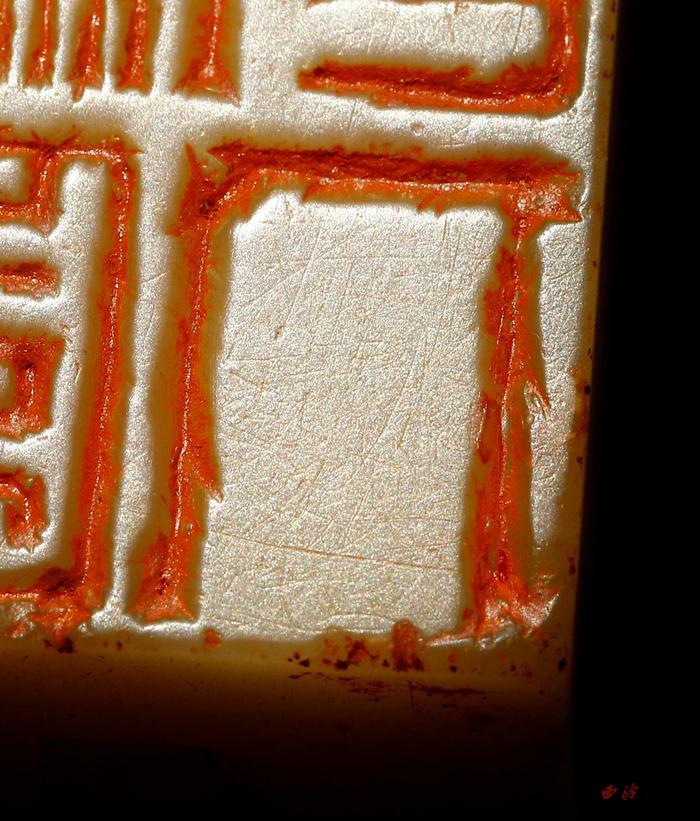
When we look at it as a whole, the four characters are all written with round stroke at the beginning to the square stroke in the end. The characters are stretched vertically mostly because there are many vertical strokes in different thicknesses and shapes. The horizontal stroke starts a bit thin but thick at the end, also varying in shape and rhythm. Square corner strokes appear where the knife edge reaches, and otherwise the strokes are almost round. The density contrast of the entire seal gives a strong visual impact, which is typical presentation of the aesthetic concepts about the density control of seal cutting art.

The calligraphy of the inscription is not all written in official script, but one extra stroke added to ‘大Da (big)’ and ‘人Ren (person) respectively turns out to be more inclined to be official script. Such a writing style can also be found in Huang Yi’s other works which were created around the same period such as Lin Yang Tai Wei Bei. As such, the whole inscription seems to be a reduced copy of the calligraphy on cliffs with its own characters.


In the same year when Huang Yi engraved this ‘Jian Yuan Lao Ren’ seal, Chen Yuzhong became a friend of Chen Mansheng who was still young and not yet offered any official post. Huang himself also had no idea about his career bound up with flood control in future. Jiang Ren, the top artist among the eight masters of Xiling Society of Seal Cutting and a man of few words, engraved ‘Zhen Shui Wu Xiang’ seal with an inscription of three hundred characters to recall his friendship with Huang Yi and his father Huang Shugu.
Two years later, Huang completed the two most important philanthropic acts. In June, he spent money and led many history researchers and scholars to reconstruct Wu Shi Shrine on the Ziyunshan Mountain. In the winter of the same year, he rescued thousands of lives by funding and offering food to the sailors from the ships which were frozen at the seventh canal lock in Shandong!
As a member of Xiling Yinshe Auction, we shall be also always ready to help others.
And, this is how the character ‘人Ren (human)’ means to us.

